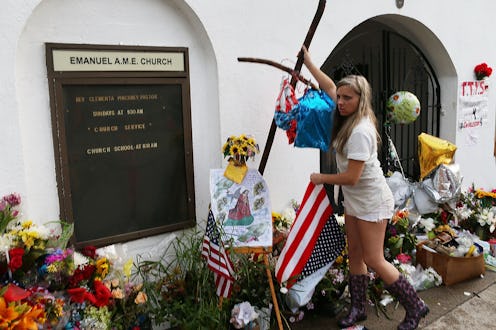Life
Why We Can't Ignore These Types Of Mass Shootings
The Huffington Post couldn't have known there would be a major shooting the very next day after they published their story about how most mass shootings happen in homes, not in schools or workplaces or streets. But in the wake of the shooting in Roanoke, it's an important read, for the simple facts they expose: The victims of most mass shootings are women and children, the perpetuators of most mass shootings are men, and because most mass shootings are the result of domestic violence, we can prevent a lot of mass shootings by dealing with domestic violence.
To whit: According to the Huffington Post, which analyzed five years of mass shooting data gathered by gun violence prevention organization Everytown For Gun Safety, 57 percent of mass shootings are targeted at a partner or family member. And 64 percent of mass shooting victims are women or children — which is particularly incredible when you consider that women make up only 15 percent and children only 7 percent of total homicide victims by firearm. For the purposes of this analysis, HuffPo considered a mass shooting to be "shootings in which at least four people were killed with a gun," although they also note that there has been some debate over whether this common definition of "mass shooting" is the most accurate.
Public mass shootings get a lot of press, and rightly so — they're horrible, and terrifying. Most of the time, these public shootings spark debate about how our country deals with gun control — an important conversation, but an incredibly contentious one. To get personal for a second, I strongly support strong gun control. When I was a kid, another child held a gun to my head and threatened to shoot, a traumatic event that probably wouldn't have happened if I grew up in, say, France, where gun control laws are strict. However, politicians in the United States have been reluctant to actually change gun control laws. But they may be able to reduce mass shootings in a different way: By putting more resources into dealing with domestic violence.
Writes the Huffington Post:
But mass shootings that happen in the home are not unpredictable. They’re frequently preceded by a flurry of red flags: 911 calls, hospitalizations, broken protective orders, repeat arrests, contentious custody battles, death threats and stalking. Before [David] Cnley allegedly killed [his ex-girlfriend, Valerie] Jackson and her entire family, he had already threatened her life multiple times and she had at least one protective order against him. At the time of her death, he was wanted on an outstanding warrant for aggravated assault.
Thanks to years of research, we know many of the risk factors for domestic homicides. Some police departments across the country are now screening women using a tool called lethality assessment to identify those at highest risk of being killed. We know that women are at a higher risk of being killed when they are attempting to leave an abusive partner, and during the period immediately after fleeing. We also know that if a woman has previously been strangled by her partner, it's an important predictor that he will later try to murder her.
The Huffington Post also points out a 2003 study that found that if an abuser has access to a gun, the victim is eight times more likely to be killed.
There are frustratingly easy ways to stop an abuser from killing his victims, along with any family members or witnesses that happen to be present: Widespread adaptation of lethality assessment, for one, and more resources like shelters and increased legal aid for those suffering from domestic violence. These comparatively uncontroversial steps could go a long way toward addressing the problem of mass shootings in America, and do so with bipartisan support. Here's hoping that politicians take up the effort.
